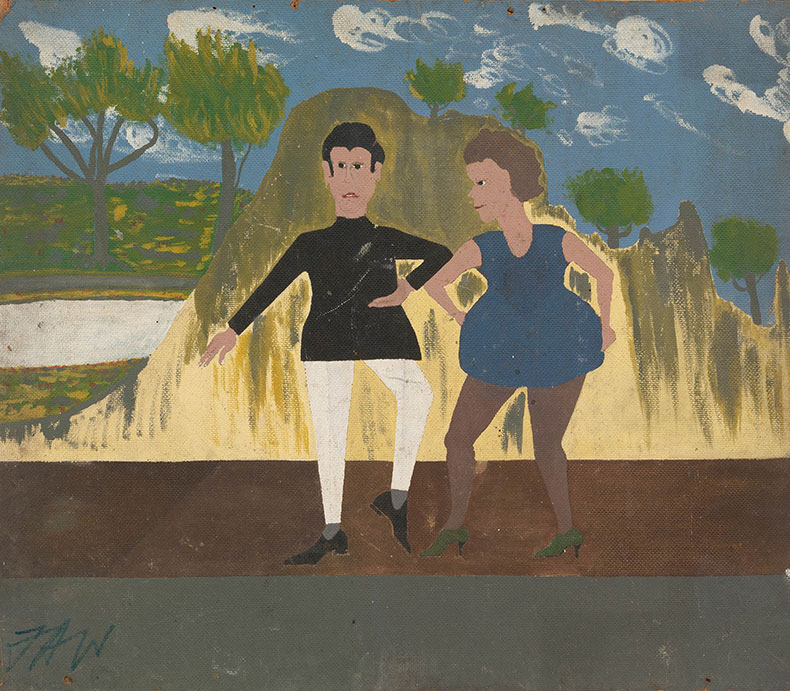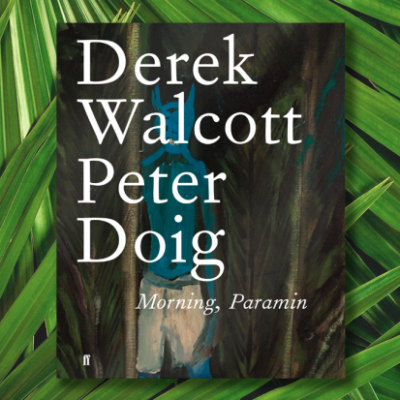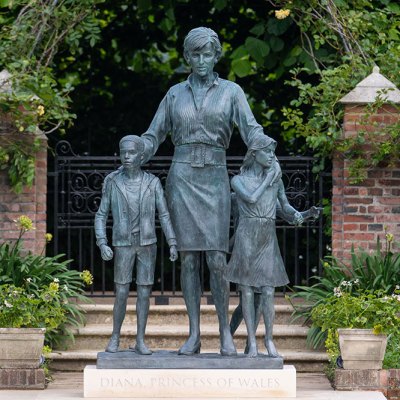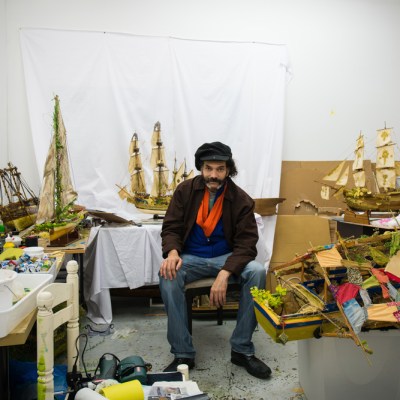From the January 2024 issue of Apollo. Preview and subscribe here.
A new exhibition dedicated to the overlooked landscape painter, writer and campaigner Frank Walter at the Garden Museum in Lambeth offers an unusual proposition. Opting for a ‘show, don’t tell’ approach, it attempts to recreate Walter’s secluded living conditions in a far-flung corner of his native Antigua where he spent his final decades – he died in 2009, at the age of 82. The house he built is conjured by a warren of narrow, dimly lit spaces demarcated in a mock-ramshackle manner using panels of wood. Through peepholes of various sizes visitors can glimpse artworks and artefacts. In the case of a series of miniature paintings made on scraps of a film-cartridge box, this format helps the viewer focus on an object that could otherwise be easily overlooked. Elsewhere, a messy array of archival documents, photographs and piles of typed-out treatises is hard to parse.
As visitors stagger out from the darkness, they are met with the sounds and smells of a tropical paradise. Brightly back-lit photographs across the walls show a contemporary vision of Antigua, complete with solar panels and plenty of plastic litter. After passing through, we are met with blue walls that presumably refer to Walter’s preference for working in an open-air studio. Here is the main display of his work, and though the selection is necessarily small compared to his prolific output, the viewer will need plenty of time to savour each painting.
Seven Palms on a Harbour (n.d.), Frank Walter. Photo: © Kenneth M. Milton Fine Arts
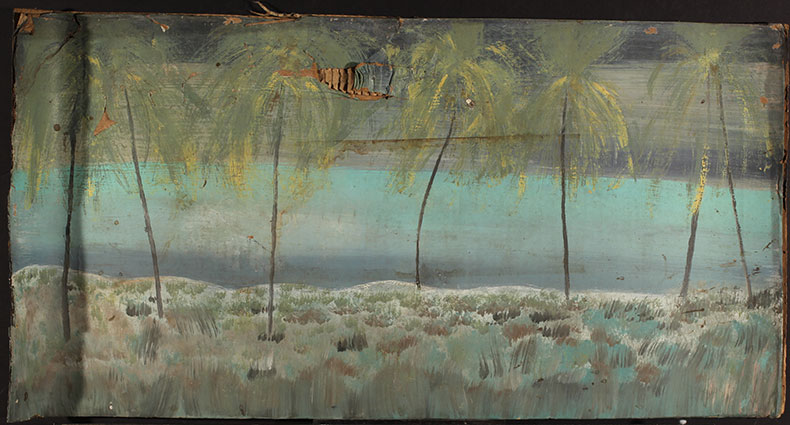
Despite his use of fragile materials which are now, in many cases, significantly damaged, Walter expertly builds up layers of pigment directly on to scraps of cardboard. A dense horizon of bright blues fading into murky pink and purple in Seven Palms on a Harbour provides a steady base over which faint wisps of visible brushstrokes denote the leaves and long grasses that rustle in an island wind. Where many landscape painters slip into dreamlike styles, Walter employs an expressive naturalism with an easy immediacy that feels true to his ever-changing environment. The compositions themselves are often simple, but there is no need to overcomplicate when not one square inch of canvas is a solid block of colour but, rather, its own rich topography of tonal variation.
Although the visitor is transported into Walter’s world, it seems that much is still unknown about his practice. None of the works are dated and at least one appears not to be labelled at all. The wall texts mainly offer biographical background, leaving the viewer to infer loose curatorial themes from the way in which paintings are grouped. For example, a handful of works with disparate, nondescript titles – Theatre, Architecture – are straightforwardly abstract, but it is not clear whether Walter moved towards abstraction over time or whether there was a particular event that triggered this exploration. Was it connected to another series of otherworldly, semi-abstract paintings inspired by the mesmerising possibilities of space and time travel, which includes Intergalactic Botany and Moon Crater (1994)? The lack of guiding narrative is unusual in a museum context, although the show is supported by David Zwirner (and the Walter Family), reflecting the growing influence of commercial galleries on public programming. A few of Walter’s paintings were offered by David Zwirner at Frieze London this year.
Man Climbing a Coconut Palm and View of Red Canoe and Boat in Harbour (n.d.), Frank Walter. Courtesy Frank Walter Family and Kenneth M. Milton Fine Arts
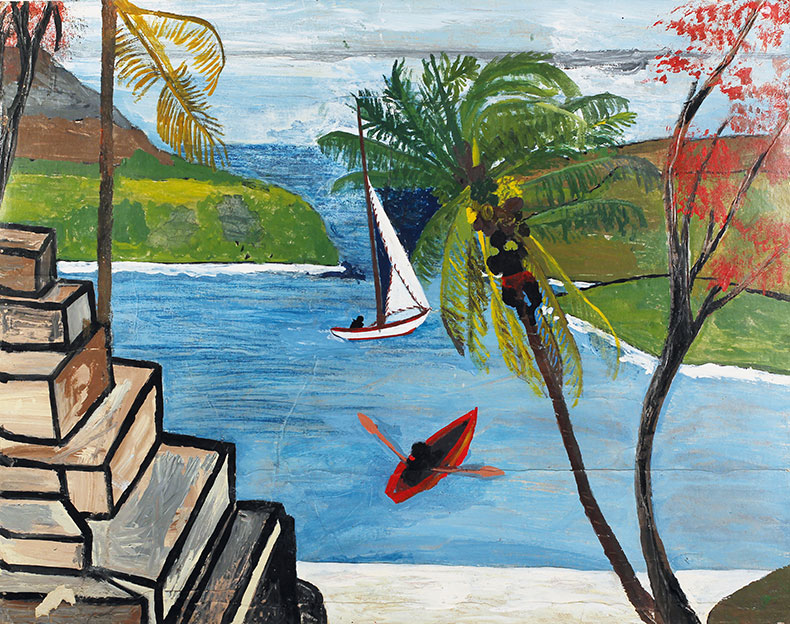
Walter built his house in the 1990s to live off the land without electricity or running water. Long before that, he had harboured more complicated ambitions. Born in 1926, he excelled at school but chose to study agriculture; by the age of 22 he had become the first Black person to manage a plantation in Antigua. Descended from both enslaved Africans and European plantation owners, he explored his mixed heritage through the construction of an aristocratic identity, sometimes depicting himself as a white royal or creating family trees that linked him to King Charles II, Franz Joseph of Austria and even Julius Caesar. One part of the exhibition contains various invented coats of arms, some featuring Antigua black pineapple or sugar cane as heraldic motifs. These two worlds collide in Adam and Eve, in which Charles and Diana, arrive in Antigua, looking painfully out of place with their awkward stances and stuffy attire.
Walter’s status anxieties were stoked by the racism he experienced after moving to the United Kingdom in 1953. He travelled with a cousin for whom he had romantic feelings, but was swiftly separated from her because she was passing as white. He watched her qualify as Antigua’s first female barrister while he struggled to find secure employment. A few of his smallest oil sketches are records from memory of the rural stretches of Scotland in which he found solace. Upon his return home, Walter became a farmer and a keen political campaigner with a bold environmental manifesto. The surrounding landscape having provided a reliable refuge throughout his life, Walter eventually retreated further into it in the years leading up to his death in 2009.
Bowl of Fruit (n.d.), Frank Walter. Courtesy Frank Walter Family and Kenneth M. Milton
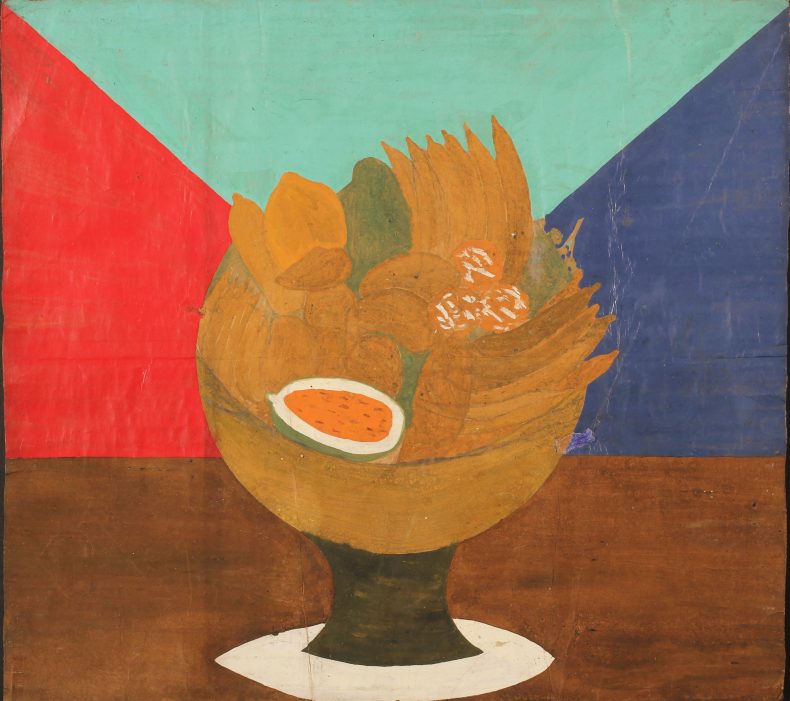
The paintings that Walter made during this latter period were mostly kept secret, but they are a charming, private document of an intentionally simple existence that now feels far beyond our reach. The fruits that Walter cultivated appear in works like Bowl of Fruit, though curiously drained of colour and drowned out by a background of bold strokes in turquoise, navy and red. Scenes seemingly inspired by everyday island life include the moody Plantation Fields and Workers, in which agricultural labourers toil under an overcast sky. Man Climbing a Coconut Palm offers a sunnier view, in which a strange vantage point, confronting flatness and a vivid palette come together to catch and keep the eye. Three small figures, almost swallowed up by the bounty of their surroundings, live in harmony with nature, reaching into a tree for food or sailing out over clear waters.
The Garden Museum is keen to highlight the relationship between these scenes and Walter’s environmentalism, as his concerns have become only more urgent. Revealing something of his motivations in the essay ‘The Value of Art’, Walter wrote, ‘art is the only thing that gives us the will to maintain our planet as a civilised community to be enjoyed by all peoples.’
‘Frank Walter: Artist, Gardener, Radical’ is at the Garden Museum, London, until 25 February 2024.
From the January 2024 issue of Apollo (and first published online). Preview and subscribe here.
